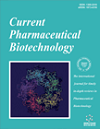-
oa Editorial [Hot Topic: ABC Transporters in Pharmacology/Physiology and Human Diseases (Guest Editor: Zhe-Sheng (Jason) Chen)]
- Source: Current Pharmaceutical Biotechnology, Volume 12, Issue 4, Apr 2011, p. 569 - 569
-
- 01 Apr 2011
Abstract
In 1976, Drs. Juliano and Ling reported that overexpression of a membrane protein in colchicine-resistant Chinese hamster ovary cells resulted in acquired resistance to many structurally unrelated antineoplastic drugs [i. e., multidrug resistance (MDR)]. The membrane protein overexpressed was later determined to be a member of the ATP-binding cassette (ABC) transporter superfamily. Based on DNA sequencing, there are at least 48 genes that code for ABC proteins in the human genome. The ABC domains of these proteins hydrolyze ATP, providing energy for transport of various substrates across the membrane against a high concentration gradient (In-to-out). The ABC transporters can be divided into seven sub-groups based on their sequence homology: ABCA (12 members), ABCB (11 members), ABCC (12 members), ABCD (4 members), ABCE (1 member), ABCF (3 members) and ABCG (5 members). The ABC genes are essential for many cellular processes, (notably protecting cells against xenobiotics and toxic endogenous molecules). The mutations in at least 13 of these genes cause or contribute to human genetic disorders. This highlighted issue of Current Pharmaceutical Biotechnology contains several reviews that summarize the role of the ABC transporters in cancer chemotherapy as well as in protecting healthy tissue from the xenobiotics and other toxic compounds. In this issue, A.K. Tiwari et al. discussed recent research regarding the involvement of ABC transporters in multidrug resistance in cancer chemotherapy. The review by R. W. Robey et al. focused on clinical interventions with ABCG2, an important ABC transporter that affects drug bioavailability, distribution, and renal excretion, as well as the development of resistance to specific antineoplastic drugs. Two in-depth articles on the latest important developments in utilizing therapeutic strategies to overcome ABC transporter-mediated drug resistance are reviewed by C-P. Wu et al. (Natural product modulators of ABC drug transporters) and E. Stolarczyk et al. (Targeting phosphorylation to regulate ABC transporter function). In addition to conferring MDR, the major physiological functions of ABC transporters include (but not limited to) the transport of cholesterol and lipids, bile salts, and peptides for antigen presentation. Many ABC transporters in the liver play an important role in controlling the chronic inflammation caused by bile acid toxicity, and this is discussed in the article of V. Ling's group. A review by P. Krishnamurthy and J.D. Schuetz emphasizes the role of ABC transporters, especially ABCB6 and ABCG2, in porphyrin metabolism and cell survival. This is interesting as ABCB6 is a recently discovered novel mitochondrial porphyrin uptake pump. Another important pharmacological/physiological function of some ABC transporters is to provide protection by effluxing xenobiotics (including drugs used to treat diseases) from tissues including brain, kidney, testes, and developing human fetus. A.M.S. Hartz and B. Bauer summarize the recent findings on ABC transporter regulation in the CNS especially at the blood-brain barrier and discuss the role of ABC transporters in CNS diseases, including brain cancer, seizures, epilepsy, and Alzheimer's disease. Another article from Z. Ni and Q. Mao provides a thorough discussion of the protective roles of ABC transporters in the placenta that attenuates toxicity in the developing fetus. It is very exciting that J.P. Gillet and M.M. Gottesman discussed how novel biotechnological approaches can be used to develop a molecular diagnostic assay to determine the expression levels of ABC transporters. It is critical to have this kind of assay (in the form of a kit) in the market for the investigation of ABC transporters and MDR in the clinic. Finally, T. Ishikawa's group presents their new biotechnologic assay (SmartAmp2 method) to detect single nucleotide polymorphisms (SNPs) in human ABC transporter genes. It is essential to validate ABC transporter genetic polymorphisms and develop new biotechnologies to rapidly detect clinically important variants of these pumps to advance the concept of individualized medical treatment. Unfortunately, due to a strict time-table for the publication of this issue, several review articles related to this topic could not be included, such as those discussing ABCC6 and Pseudoxanthoma elasticum (PXE), ABCC7 and cystic fibrosis, ABCG5/G8 and plant sterol transport. We hope that these articles will be published in a future issue of this journal. In this special issue, we have reviewed the functions of ABC transporters, emphasizing biochemical mechanisms and genetic defects. The topics covered by experts in this field will illustrate the importance of ABC transporters in pharmacology, physiology and human diseases. I would like to express my appreciation to all the authors for their contributions. I thank Dean R. Mangione, College of Pharmacy and Allied Health Professions, St. John's University, Chairman, L. Trombetta (Department of Pharmaceutical Sciences, St. John's University) for their encouragement and support. I would like to extend my thanks to my colleague Dr. C.R. Ashby, Jr. my postdoctoral fellows, visiting scholars and graduate students for their critical reading of this editorial and the format of the articles in this issue.


